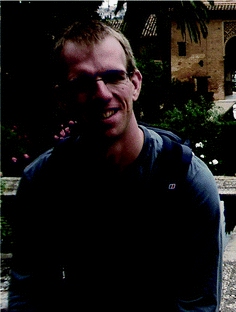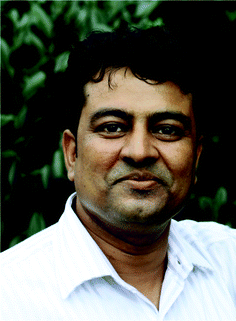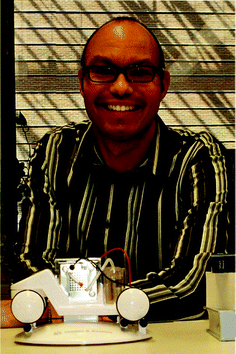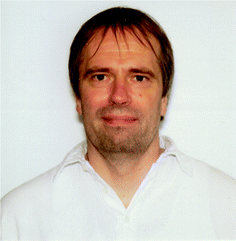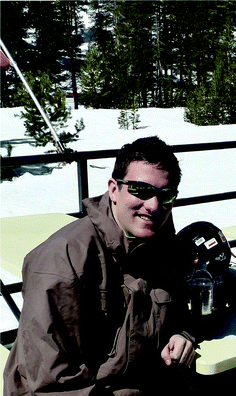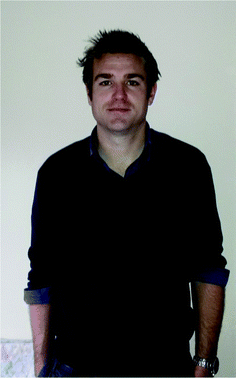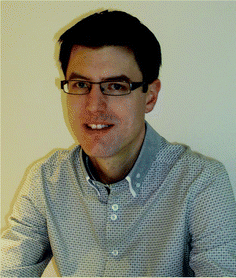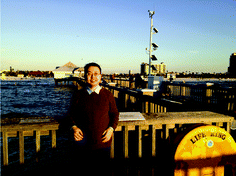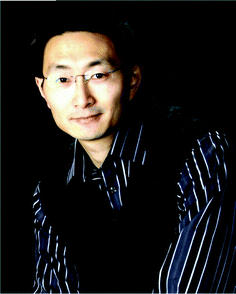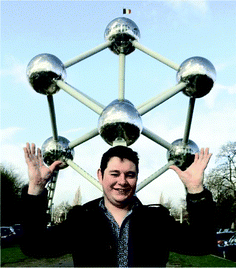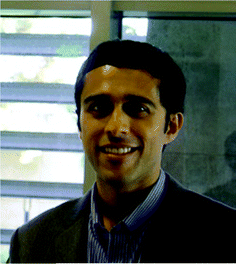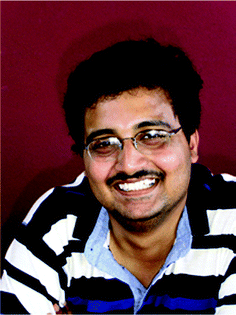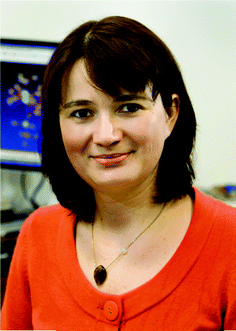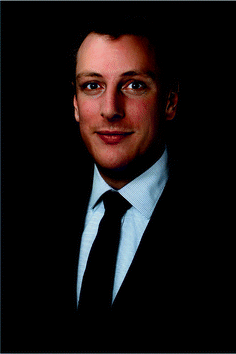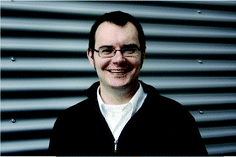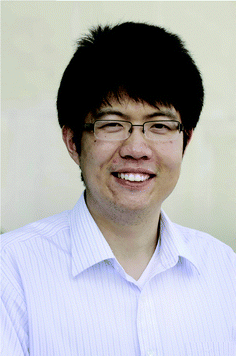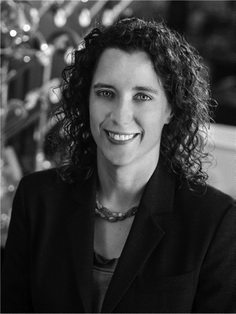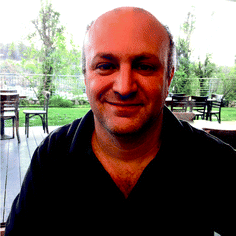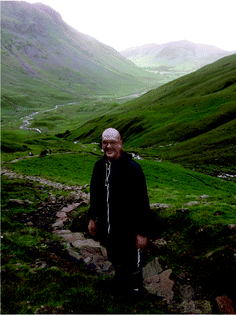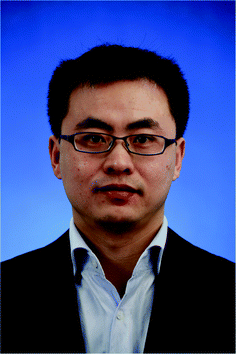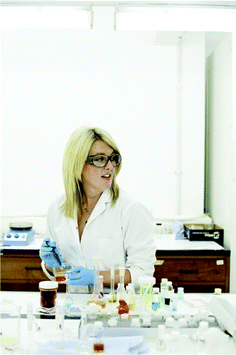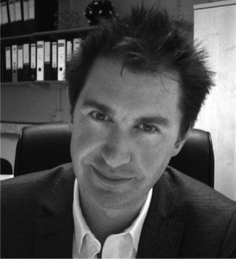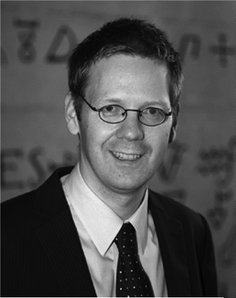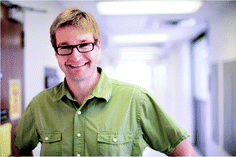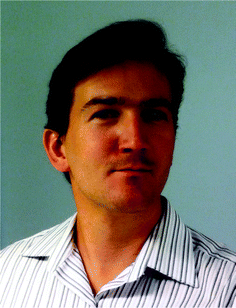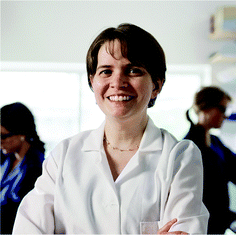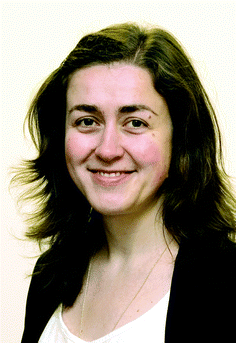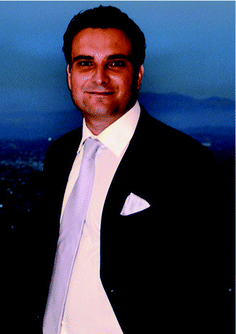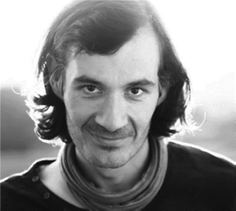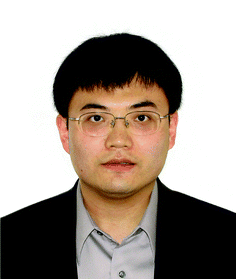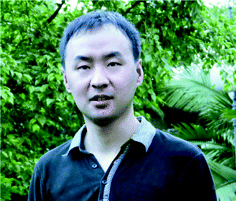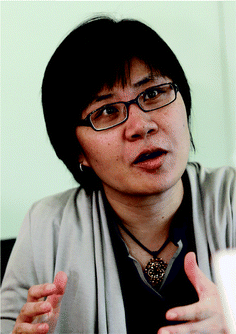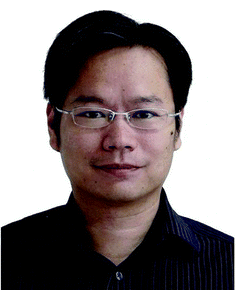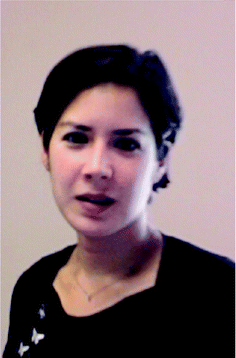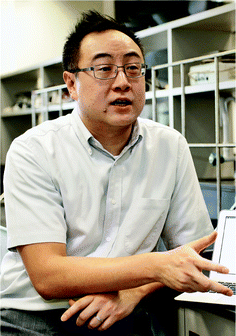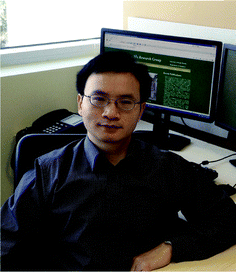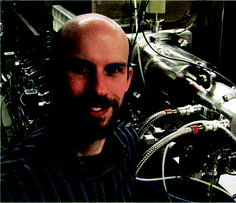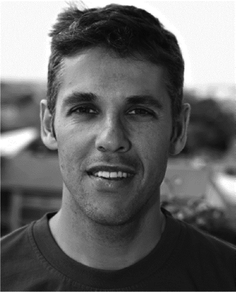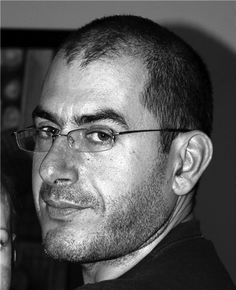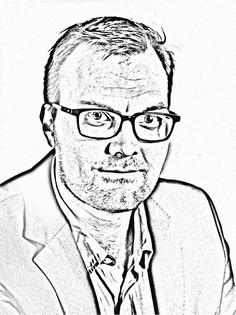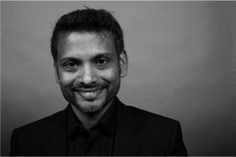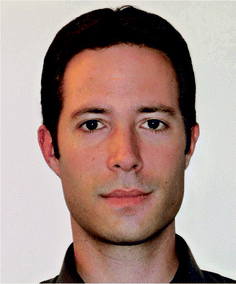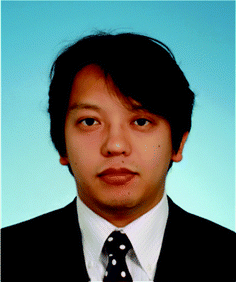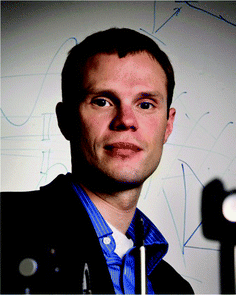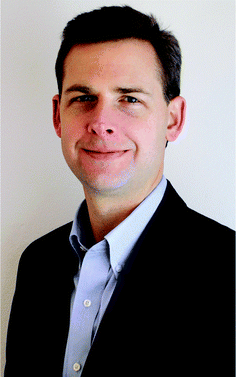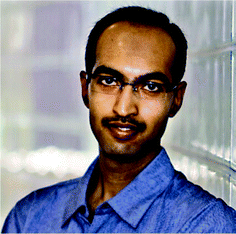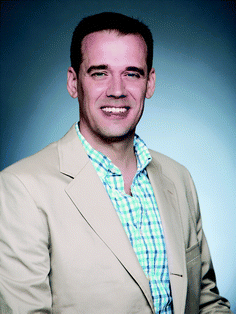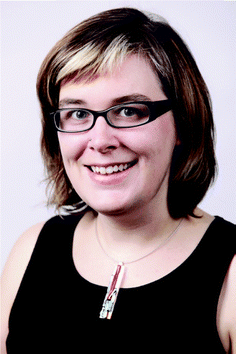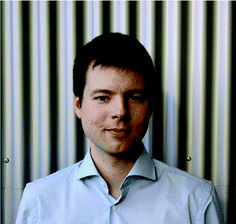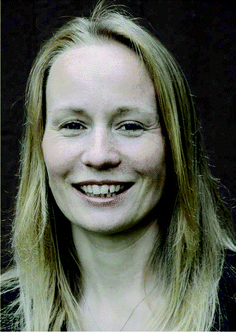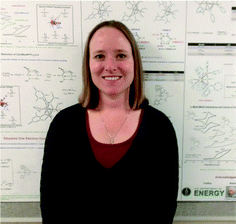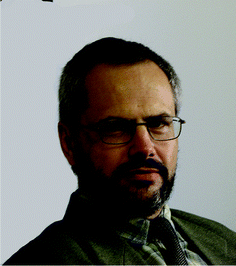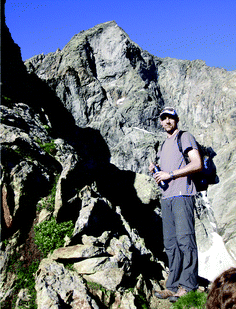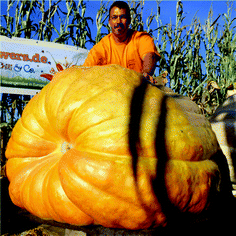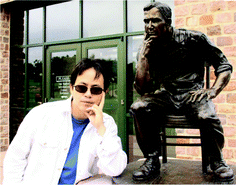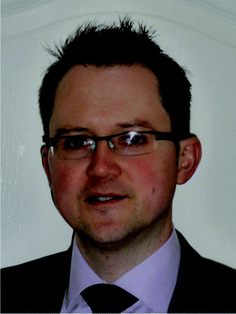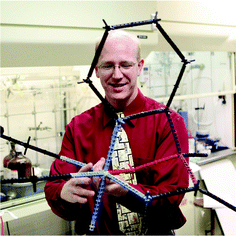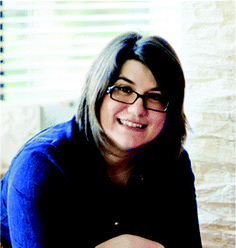DOI:
10.1039/C4CC90109F
(Front/Back Matter)
Chem. Commun., 2014,
50, 5100-5114
Contributors to the Emerging Investigators Issue 2014
First published on 8th April 2014
Ed Anderson obtained his PhD with Prof. Andrew Holmes at the University of Cambridge, and carried out postdoctoral research with Prof. Erik Sorensen, and Prof. Ian Paterson. In 2007 he took up an EPSRC Advanced Research Fellowship at Oxford, and in 2009 was appointed to a University Lectureship. His research interests are wide-ranging, and include cascade reactions, organopalladium and organosilicon chemistry. Outside of the lab, he enjoys triathlon-related sports, and having the rest of his time used up by his two children.
Nirmalya Ballav obtained his MSc (organic chemistry) in 2000 and PhD (physical chemistry) in 2005 from the University of Calcutta, India. After his postdoctoral research at the University of Heidelberg, Germany and the Paul Scherrer Institute, Switzerland, he returned to India and joined Department of Chemistry, IISER Pune in 2011 as an Assistant Professor. He is also a Visiting Scientist at the Paul Scherrer Institute. He was among the top five finalists for the Gerhard Ertl Young Investigator Award 2011 for excellent research contributions in Surface Science and recipient of the Holcim Fellowship 2011. Current research interests of his group include on-surface coordination- and magneto-chemistry, molecular self-assembly, supramolecular chemistry, electron-beam lithography, organic–inorganic hybrids and molecular spintronics.
Bart M. Bartlett is the Seyhan N. Eğe Assistant Professor of Chemistry at the University of Michigan. Bart entered the world of scientific research in 1995 while a junior at Metro High School (St. Louis, MO, USA), working in a worm genetics lab at the Washington University School of Medicine. He has since trained in chemistry at Washington University, MIT, and UC Berkeley. Now, he and his talented research team develop new compounds and architectures for energy conversion and storage. In addition to writing manuscripts, grants, and lectures, Bart remains a loyal fan of his hometown St. Louis Cardinals.
Stefan Bernhard started his chemistry career as a laboratory technician with Chocolat Tobler, which was followed by a degree in chemical engineering from the Ingenieurschule Burgdorf. Further endeavours, under Prof. Peter Belser at the Université de Fribourg, were rewarded with a diploma and a PhD in chemistry. These primarily synthetic studies were complemented by a laser spectroscopy project at Los Alamos National Laboratory with Dr Jon Schoonover and time in the Abruña group at Cornell University focused on electrochemistry. Stefan Bernhard's faculty appointment at Princeton University explored luminescent metal complexes for optoelectronic and solar conversion applications. He moved to Carnegie Mellon University in July 2009 where he holds an Associate Professor position.
Richard A. Bourne is currently a Tenure Track Fellow at the University of Leeds. Richard studied chemistry at the University of Nottingham where he obtained a Masters in chemistry. He remained at Nottingham and completed a PhD under the supervision of Prof. Martyn Poliakoff, CBE, FRS, followed by postdoctoral research with Prof. Martyn Poliakoff and Prof. Michael W. George looking at reactions of singlet oxygen as part of the EU FP7 SYNFLOW project. He now works at the Institute of Process Research and Development (IPRD) at Leeds, working on rapid process development and continuous flow chemistry.
Thomas W. Chamberlain graduated with a MSc in chemistry in 2005 before completing a PhD on the synthesis of novel functional fullerene molecules and the subsequent formation of fullerene/carbon nanotube peapod structures, 2009, both at the University of Nottingham. He joined the Nottingham Nanocarbon group as a Postdoctoral Research Associate on an ESF project using supramolecular forces, such as van der Waals, to organise molecules in 1D and 2D arrays utilising carbon nanotubes as quasi 1D templates. He currently works on an ERC grant developing carbon nanotubes as catalytic nanoreactors for the formation of novel molecular and nanostructured products.
James A. Bull is a Research Fellow in the Department of Chemistry at Imperial College London. He obtained his MSc from the University of Cambridge, then spent a year at GlaxoSmithKline. He returned to the University of Cambridge to obtain his PhD in organic chemistry under the supervision of Prof. Steven V. Ley (2006). He then spent two years undertaking postdoctoral research with Prof. André B. Charette at Université de Montréal. In 2009 he joined Imperial College London as a Ramsay Memorial Research Fellow. In 2011 he was awarded an EPSRC Career Acceleration Fellowship on strategies to access novel heterocycles of interest in drug discovery.
Jianfeng Cai is currently an Assistant Professor in the Department of Chemistry, University of South Florida. He received his BS and MS from Nanjing University in 1997 and 2000, respectively. In 2006, he obtained his PhD under the supervision of Dr John-Stephen A. Taylor at Washington University in St. Louis. He then moved to Yale University and worked as a Postdoctoral Associate with Dr Andrew D. Hamilton from 2007 to 2009, before accepting his current position at USF. His research focus is bioorganic chemistry and chemical biology, especially the design and application of peptidomimetics.
Qianli ‘Rick’ Chu is an Assistant Professor of Chemistry at the University of North Dakota, USA. Chu is a native of China where he began his research career at the Shanghai Institute of Organic Chemistry (SIOC) after receiving his BS from Shanghai University in 1997. He received his PhD at the University of Iowa in 2005 with Prof. Leonard R. MacGillivray. He did postdoctoral work with Prof. Dennis P. Curran at the University of Pittsburgh after which he joined the faculty at the University of North Dakota. Chu is best known for his independent work on supramolecular atropisomers.
Scott Cockroft: Following his PhD with Prof. Christopher Hunter FRS, Scott departed his beloved Yorkshire in 2006 and headed to California to conduct postdoctoral work with Prof. M. Reza Ghadiri at The Scripps Research Institute. In 2007, Scott moved to the land after which he was named to take up a lectureship at the University of Edinburgh. He is extremely grateful to Brussels (pictured) for funding his recently awarded ERC Starting Grant. The Cockroft group are currently investigating molecular recognition in synthetic model systems, while harnessing these principles in the construction of molecular machines built from biological components.
Neal K. Devaraj is an Assistant Professor of Chemistry and Biochemistry at the University of California, San Diego (UCSD). A native of Southern California, he received a dual BS in chemistry and biology from the Massachusetts Institute of Technology and subsequently obtained a PhD in chemistry from Stanford University under James P. Collman and Christopher E. D. Chidsey. Following this, he moved to the Harvard Medical School where he did postdoctoral work with Ralph Weissleder. Currently, his laboratory is developing bioorthogonal reactions as tools in molecular imaging and synthetic biology. His group's research has been recognized by a NIH Career Development award, a NSF CAREER award, and a Department of Defense MURI award.
Abhishek Dey obtained his undergraduate degree from the Presidency College, Calcutta, India and his PhD from Stanford University, CA, USA. He joined IACS in June 2009 as an Assistant Professor and is currently serving as an Associate Professor at the same department. He is the recipient of the American Chemical Society Division of Inorganic Chemistry Young Investigator Award. His current area of research involves development of homogeneous and heterogeneous catalysts for sustainable energy,
e.g. O
2 reduction, H
+ reduction, H
2O oxidation. A combination of synthesis, self-assembly, spectroscopy, electrochemistry and electronic structure calculations are used to attain these research goals.
Paula Diaconescu joined the UCLA Chemistry & Biochemistry Department in 2005, after spending two years as a Postdoctoral Fellow in the group of Prof. Robert Grubbs at the California Institute of Technology. She obtained her PhD degree under the supervision of Prof. Christopher Cummins at Massachusetts Institute of Technology. She has received the Alfred P. Sloan Fellowship and the NSF CAREER Award, and is an Editorial Board member for the journals
Organometallics and
Inorganic Chemistry Frontiers. The Diaconescu research group is interested various aspects of metal–ligand cooperation as they stem from using ferrocene-based supporting ligands, with applications ranging from small molecule activation to the formation of biodegradable polymers.
Jeroen Dickschat studied chemistry at the Institute of Technology Braunschweig. His PhD with Prof. Stefan Schulz was dedicated to volatile natural products from bacteria, a strongly neglected, but today more and more recognised field of natural product chemistry. After postdoctoral stays with Prof. Rolf Müller at Saarland University and with Prof. Peter Leadlay at the University of Cambridge he returned to Braunschweig to further develop his research on natural volatiles. His interest in flavours is not only expressed in more than 50 scientific publications, but also in his passion for cooking that is also inspired by many aroma compounds.
Benjamin Dietzek: Having studied physics in Würzburg and Stony Brook, he went into physical chemistry for his PhD studies. Being fascinated by the possibility to investigate ultrafast chemical reactions and photoinduced dynamics, Benjamin's PhD project focused on the characterization of light-driven processes in natural and artificial chromophores. Postdoctoral stays at Lund University and MIT were followed by his habilitation at the University of Jena, Germany. In 2011 he was appointed Professor of Physical Chemistry at the Institute of Photonic Technology Jena and Friedrich-Schiller-University Jena. Currently, his work is focused not only on the spectroscopic characterization of photoinduced processes and ultrafast photochemistry but extends to the synthesis and structural characterization of semiconductor–molecular interfaces.
Guangbin Dong received his BS degree from Peking University and completed his PhD degree in chemistry from Stanford University with Prof. Barry M. Trost, where he was a Larry Yung Stanford Graduate fellow. In 2009, he began research with Prof. Robert H. Grubbs at California Institute of Technology, as a Camille and Henry Dreyfus Environmental Chemistry Fellow. In 2011, he joined the Department of Chemistry and Biochemistry at the University of Texas at Austin as an Assistant Professor and a CPRIT Scholar. His research interests lie in the development of powerful chemical tools for addressing questions of biological importance.
Rachel Evans is an Assistant Professor (since 2011) in the School of Chemistry at Trinity College Dublin, Ireland. She obtained her MChem (2002) and PhD (2007) from Swansea University, UK under the supervision of Dr Peter Douglas and was awarded the RSC Ronald Belcher Award for her PhD studies. She subsequently moved to Portugal as an FCT Postdoctoral Fellow between the Universities of Coimbra and Aveiro with Prof. Hugh D. Burrows and Prof. Luis D. Carlos. Rachel is a co-editor of the book
Applied Photochemistry (Springer, 2013) and her current research focuses on harnessing self-assembly strategies to design photoactive hybrid materials for application in optical sensors, solar energy conversion and light-emitting displays.
François-Xavier Felpin was born in Villefranche-sur-Saône, France, in 1977. He received his PhD degree in 2003 from the University of Nantes under the supervision of Prof. Jacques Lebreton working on synthesis of alkaloids. After his PhD, he was engaged in a postdoctoral position with Prof. Robert S. Coleman at The Ohio State University working on the total synthesis of Mitomycin. In 2004 he joined the University of Bordeaux as an Assistant Professor and he received his habilitation in 2009. In fall 2011, he moved to the University of Nantes as a Full Professor. In 2012, François-Xavier Felpin was elected as a member of the
Institut Universitaire de France. His research interests encompass heterogeneous and homogeneous sustainable catalysis as well as medicinal chemistry.
Eric M. Ferreira received his undergraduate degree in chemistry at MIT in 2000, where he worked in the laboratories of Stephen Buchwald. He next moved to Caltech, where he studied palladium-catalyzed oxidations as an NSF Graduate Fellow under the direction of Brian Stoltz. He received his PhD in 2005, and then went on to study cycloisomerization chemistry with Barry Trost at Stanford University as an ACS Postdoctoral Fellow. He started his independent career at Colorado State University in 2008, where he has established a research program focused on the design of synthetic transformations based on transition metal catalysis.
Annaliese Franz completed her BS in chemistry at Trinity University where she first became involved with asymmetric catalysis working in the laboratory of Michael Doyle. She carried out her PhD studies under the direction of Keith Worpel developing new methodology with organosilicon compounds, and earned a PhD in organic chemistry from the University of California Irvine in 2002. She completed an NIH Postdoctoral Fellowship at Harvard University working under the guidance of Stuart Schreiber. In 2007 she joined the Department of Chemistry at University of California Davis to start her independent career as an Assistant Professor where her research focuses on synthetic methodology, organosilicon chemistry, and asymmetric catalysis.
Assaf Friedler was born in Israel in 1971. He received his PhD in peptide chemistry and medicinal chemistry from the Hebrew University of Jerusalem, Israel, in 2000. From 2000–2004 he did his postdoc in the field of biophysical studies of protein–protein interactions at the MRC Centre for Protein Engineering, Cambridge, UK, in the laboratory of Prof. Sir Alan Fersht. In 2004 he joined the Institute of Chemistry at the Hebrew University of Jerusalem, Israel. Since 2010 he has been Professor of Chemistry and the Head of the School of Chemistry at the Hebrew University. His major research interests are using peptides to study protein–protein interactions in health and disease, and developing peptides as drugs that modulate these interactions. (http://chem.ch.huji.ac.il/∼assaf/). Prof. Friedler won a starting grant from the ERC (European Research Council) as well as the Outstanding Young Scientist prize of the Israeli Chemical Society.
Tomislav Friščić is an Assistant Professor at McGill University. He received his BSc at the University of Zagreb with Branko Kaitner, followed by a PhD with Len MacGillivray at the University of Iowa. He was a Postdoctoral Associate with William Jones and a Herchel Smith Research Fellow at the University of Cambridge. His group is developing solid-state catalytic and self-assembly methodologies in diverse areas of organic, metal–organic, pharmaceutical and materials synthesis. He has co-authored >100 research and review articles and was awarded the 2011 RSC Harrison-Meldola Medal. In 2013 he joined the Editorial Board of
CrystEngComm and is currently organising several upcoming mechanochemistry-oriented conferences, particularly Faraday Discussions (2014) and a Pacifichem symposium (2015).
Matthew Fuchter's doctoral and postdoctoral work led him from macrocycles and medicine with Prof. A. G. M. Barrett, FRS FMedSci (Imperial College London) to supercritical solvents with Prof. A. B Holmes, FRS (CSIRO/University of Melbourne). Following a short subsequent spell as an RCUK Academic Fellow at the School of Pharmacy, University of London, he returned to Imperial College London as a member of the Faculty in 2008. He has broad scientific interests, focused around the design, synthesis and study functionally important molecules in chemistry, materials and medicine.
Shuanhu Gao was born in Ningxia Province, China, in 1979. He received his BS degree from Lanzhou University in 2001. In 2006 he earned his PhD from Lanzhou University under the direction of Prof. Yongqiang Tu. From 2007 to 2010, he was a Postdoctoral Fellow in Professor Chuo Chen's group at the UT Southwestern Medical Center at Dallas. He started his independent career as a Professor in the Department of Chemistry at East China Normal University in October 2010. His current research interests are primarily focused on the synthesis of complex natural products and medicinal chemistry.
Libby Gibson was awarded a University of Nottingham Anne McLaren Research Fellowship and a Royal Society Dorothy Hodgkin Research Fellowship in 2010, having spent 3 years as a postdoc at the Centre for Molecular Devices, Uppsala University, Sweden, developing dye-sensitized solar cells. She completed her PhD in 2007 at the University of York, supervised by Robin Perutz FRS and Anne-Kathrin Duhme-Klair. Research in her group focuses on solar cell and solar fuel devices that function at a molecular level and challenge the conventional solid-state photovoltaic technologies.
Pedro Gois (Portugal, 1977) studied chemistry at the New University of Lisbon where he also received his PhD in 2005 under the supervision of Carlos Afonso. From May 2005 to May 2008 he worked as a postdoc at the University of Sussex with F. Geoffrey N. Cloke, University College London with Stephen Caddick and at the Instituto Superior Técnico with Carlos Afonso on the development of novel organic transformations catalyzed by NHC–metal complexes. In 2008 he joined the Pharmacy Faculty in Lisbon as an Assistant Research Fellow where in 2013 he became Principal Investigator. His research encompasses the development of methodologies for the preparation of small molecule modulators of enzymes, the development and evaluation of generic synthetic methods to modified proteins, and the synthesis of biologically active boron containing chemical probes and their evaluation as modulators of specific proteins.
Andrew Goodwin is an Associate Professor of Inorganic Chemistry at the University of Oxford. His research career started at the University of Sydney, where he studied under Cameron Kepert. He moved to Cambridge in 2002 to work with Martin Dove, was elected to a Trinity College Junior Research Fellowship in 2004, and then appointed to a Lectureship at Oxford in 2009. His research focuses on exploiting flexibility and disorder in functional materials and is generously supported by the EPSRC and ERC. Andrew is the grateful recipient of the RSC's Harrison-Meldola (2010) and Marlow (2013) awards.
Christian Heinis obtained his PhD from the ETH Zurich under the supervision of Prof. Dr Dario Neri. He was a Postdoctoral Fellow in the group of Prof. Dr Kai Johnsson at the EPFL and in the group of Sir Gregory Winter at the Laboratory of Molecular Biology (LMB) in Cambridge, UK. In 2008 he was appointed Assistant Professor at the EPFL in Lausanne. Since 2009 he has held a Professorship of the Swiss National Science Foundation. His main research goal is the development of novel peptide formats for the generation of therapeutics with a special focus on bicyclic peptides.
Michael Ingleson was born and bred in South Wales before he moved across the border to the University of Bath. His PhD was supervised by Prof. Andrew Weller with subsequent postdocs with Prof. Kenneth Caulton and Prof. Matthew Rosseinsky. Mike commenced his independent career in 2008 with a Royal Society University Research Fellowship. Current research interests are centred on developing new synthetic methodologies utilising precious metal free catalysts/reagents, with a particular focus on cationic main group electrophiles. Outside chemistry Mike is a dedicated squash player and enthusiastic supporter of the NG Dragons and the Welsh rugby team.
David Jenkins was born and raised in the “western gate to the sunshine state,” Pensacola, Florida. He received his BA in chemistry in 2000 from Cornell University and conducted undergraduate research under Héctor Abruña. His graduate studies at Caltech with Jonas Peters focused on the stabilization of novel metal–imide bonds on pseudo-tetrahedral cobalt complexes. After completion of his PhD in 2005, he joined the laboratory of Jeffrey Long as a Miller Fellow at UC Berkeley where he investigated molecular magnets. Since 2008, David has been as Assistant Professor at the University of Tennessee where his research program focuses on synthetic inorganic chemistry with emphases on catalytic systems for oxidative group transfer reactions and nanoporous breathing materials. When he is not in the lab, David enjoys road cycling and kayaking across east Tennessee.
Adrian Keatinge-Clay has been an Assistant Professor at the University of Texas at Austin since 2008. His scientific career has focused on visualizing and harnessing polyketide assembly lines. His lab utilizes domains and modules isolated from these assembly lines as biocatalysts in the synthesis of chiral building blocks and medicinally-relevant polyketide fragments. Adrian anticipates that in the future polyketides will be generated through automated synthesis much like polypeptides and oligonucleotides.
Pamela Kreeger is an Assistant Professor in the Department of Biomedical Engineering at the University of Wisconsin-Madison. She earned a BS in chemistry from Valparaiso University, a PhD in Chemical Engineering at Northwestern University, and was a Postdoctoral Fellow in Biological Engineering at MIT. Her lab utilizes tools from systems biology and tissue engineering to determine how the interactions between multiple components of the disease microenvironment influence cellular phenotypic decisions. She is the recipient of a NSF CAREER award and is an American Cancer Society Research Scholar. Photo credit: David Nevala Photography.
Marina Kuimova is the EPSRC Career Acceleration Fellow in the Chemistry Department at Imperial College London. Following an MSc Degree in chemistry from Moscow State University in 2001, she moved to the University of Nottingham, where she obtained a PhD under the supervision of Mike George. After a two-year period as a Postdoctoral Associate at Imperial College she obtained an independent fellowship from the EPSRC and concentrated on imaging of the biological environment during photodynamic therapy. Her current research is focused on designing fluorescent probes for microscopic viscosity in samples of interest to biology, medicine, atmospheric and materials sciences.
Emmanuel Kymakis (1977) received his PhD from Cambridge University in 2003. He is an Associate Professor at the Electrical Engineering Department of TEI of Crete and heads the Nanomaterials & Organic Electronics group. His research topics include investigation of the opto-electronic properties of graphene, layered crystals and inorganic–organic hybrids for the development of low cost flexible photovoltaics. He has over 50 publications with over 2500 citations and has given 35 invited lectures. He has been selected as an honorary lecturer in the UConn, and was a recipient of an Isaac Newton and an EPSRC studentship. He is currently the national representative in two ESF COST actions and a member of the Graphene Flagship.
Sylvain Ladame received his PhD in chemistry of biomolecules from the University of Toulouse, France, in 2001 after working on enzyme inhibitors under the supervision of Dr Michèle Willson. He then travelled to Cambridge, UK, to work for five years as a Postdoctoral Researcher in the group of Prof. Shankar Balasubramanian. In 2006, he returned to France as a CNRS researcher and started his independent research career as a junior group leader with the Institute of Science and Supramolecular Engineering (ISIS, Strasbourg, France). Four years later, in 2010, he became a lecturer in the Department of Bioengineering at Imperial College London, UK, where he is currently leading a research group interested in the molecular recognition of nucleic acids with engineered small molecules for sensing (probes) and therapeutic (drugs) applications.
Jungkyu K. Lee is an Assistant Professor in the Department of Chemistry at Kyungpook National University in Korea. He received his BS from Pusan National University in 2002, MS from KAIST (with Prof. Insung S. Choi) in 2004, and PhD from Stanford University (with Prof. Zhenan Bao) in 2010. After two years of postdoctoral research at Massachusetts Institute of Technology (with Prof. Hadley D. Sikes), he joined the faculty at Kyungpook National University in 2012. His research interests include biosurface organic chemistry, non-biofouling polymers, conjugated polymers, bioconjugation, and nanobiotechnology with particular emphasis on organic electronics and nanobiosensors at the molecular level to break Aristotle's principle, “the whole is greater than the sum of its parts”.
Ang Li was born in Jilin, China in 1982. He received BSc from Peking University, China in 2004, where he worked with Prof. Zhen Yang. He then went to The Scripps Research Institute, USA, for graduate study under the supervision of Prof. K. C. Nicolaou and received his PhD in 2009. After a brief stay at the Nicolaou lab at the Institute of Chemical and Engineering Sciences, Singapore, as a Postdoctoral Fellow, he started his independent career at Shanghai Institute of Organic Chemistry, Chinese Academy of Sciences. His research interests focus on the total synthesis of biologically and structurally interesting natural products.
Xuechen Li received his PhD from Harvard University (2006). After postdoctoral study with Prof. Samuel Danishefsky at the Memorial Sloan-Kettering Cancer Center (2007–2009), he joined The University of Hong Kong as an Assistant Professor in 2009. His research interests include exploring new methods for protein/glycoprotein synthesis, protein labeling/modification and chemical glycobiology.
Mi Hee Lim is an Associate Professor in the School of Nano-Bioscience and Chemical Engineering at the Ulsan Institute of Science and Technology (UNIST), Ulsan, Korea. She obtained her MSc under the direction of Prof. Wonwoo Nam at Ewha Womans University, Seoul, Korea, in 2001 and her PhD under the supervision of Prof. Stephen Lippard at MIT, MA, USA in 2006. After her PhD, Dr Lim moved to Caltech, CA, USA, where she was a TRDRP Postdoctoral Fellow in the laboratory of Prof. Jacqueline Barton. In August 2008, she began her independent position at the University of Michigan, Ann Arbor, MI, USA, and has recently joined UNIST. Her current research focuses on elucidating the roles of metals and proteins in neurodegeneration.
Wenwei Lin received his BS degree in chemistry from the National Taiwan Normal University in 1998, his MS degree (supervisor: Prof. Dr Ching-Fa Yao) in organic chemistry from the National Taiwan Normal University in 2000, and his PhD (
summa cum laude; supervisor: Prof. Dr Paul Knochel) in organic chemistry from Ludwig-Maximilians-Universität München, Germany, in 2006. After his postdoctoral work at Technische Universität Berlin, Germany, he started his independent research career in the Department of Chemistry at the National Taiwan Normal University (since 2008) and was promoted to Associate Professor in 2011. His research interests include development of organophosphane-mediated synthetic methodologies and asymmetric organocatalysis.
Jason Locklin obtained his BS in chemistry (1999) from Millsaps College and his PhD in chemistry (2004) at The University of Houston with Rigoberto Advincula. In 2005, he moved to Stanford University as an Intelligence Community Postdoctoral Fellow where he worked with Zhenan Bao in the Department of Chemical Engineering. In 2007, he joined the faculty at the University of Georgia as an Assistant Professor in the Department of Chemistry and College of Engineering. He was promoted to Associate Professor in 2011. Jason has been awarded the Central Intelligence Agency Young Investigator Award (2007) and the NSF CAREER Award (2010). His group is currently investigating surface-initiated polymerization reactions, orthogonal self-assembly, Kumada-transfer polycondensation, antimicrobial surfaces, and stimuli-responsive interfaces and gels.
Christine Luscombe obtained her PhD from the University of Cambridge in 2005 and worked with Prof. J. M. J. Fréchet at UC Berkeley for her postdoctoral studies. She started her position as an Assistant Professor in the Materials Science and Engineering Department in 2006, and was promoted to Associate Professor in 2011. She was appointed Adjunct Professor for the Department of Chemistry in 2013. Her research area focuses on the synthesis of semiconducting polymers and their hybrid materials. In her free time, Christine enjoys rowing, hiking, and kickboxing.
Dik-Lung Ma completed his PhD in 2004 at the University of Hong Kong under the supervision of Prof. C.-M. Che. He spent the years 2005–2009 at the University of Hong Kong, the Hong Kong Polytechnic University, and the Scripps Research Institute with Prof. C.-M. Che, Prof. K.-Y. Wong, and Prof. R. Abagyan. In 2010, he was appointed as an Assistant Professor at the Hong Kong Baptist University. His research mainly focuses on luminescent sensing for biomolecules and metal ions, computer-aided drug discovery, and inorganic medicines.
Shengqian Ma received his BS degree from Jilin University, China in 2003, and graduated from Miami University, Ohio, with a PhD degree under the supervision of Hong-Cai Joe Zhou (currently at Texas A&M University) in 2008. After finishing a two-year Director's Postdoctoral Fellowship at Argonne National Laboratory, he joined the Department of Chemistry at University of South Florida as an Assistant Professor in August 2010. His current research interest focuses on the development of functional porous materials for energy and biological-related applications including heterogeneous catalysis, biocatalysis and fuel cells.
Jeffrey Mativetsky is an Assistant Professor in the Department of Physics at Binghamton University, where he leads the Organic Electronics and Solar Cell Laboratory. His research is focused on nanoscale structure–function relationships in organic electronic systems. He received his PhD in Physics from McGill University (2006) and was a recipient of the Japan Society for the Promotion of Science Summer Fellowship, held at Kyoto University (2006), the Marie Curie Fellowship, held at the Supramolecular Science and Engineering Institute in France (2007–2010), and the Camille and Henry Dreyfus Environmental Chemistry Fellowship, held at Princeton University (2010–2012).
Michael M. Meijler was born in 1970 in Amsterdam, The Netherlands. He combined studies in chemistry at the University of Amsterdam with competitive distance running (3000 meters steeplechase). After completing his PhD studies at The Weizmann Institute of Science in Israel with Abraham Shanzer, he joined the group of Kim Janda at The Scripps Research Institute in 2002 as a Postdoctoral Fellow and from 2005 to 2006 as an Assistant Professor. In October 2006 he returned to Israel for a faculty position at the Department of Chemistry at Ben-Gurion University of the Negev in Be'er Sheva, and was promoted to Associate Professor in 2011. His research interests focus on chemical communication within and between species.
Marco Montalti obtained his PhD in Chemical Sciences in 2001 at the University of Bologna after being a research assistant at Tulane University. In 2002 he started his independent research career as an Assistant Professor in the field of fluorescent silica and metal nanoparticles. His research group works on the design of (nano-)systems and devices based on the integration of molecular, supramolecular and nanostructured functional components for application in life and material sciences. Part of their research is dedicated to methods and tools for real time and real space investigation of biological and chemical processes.
Kasper Moth-Poulsen (KMP) received his BSc, Cand. Scient. and PhD degrees in chemistry from the University of Copenhagen, Denmark. He was a Postdoctoral Fellow at the University of Copenhagen (with Prof. Bjørnholm) and then at the University of California at Berkeley (with Profs. Segalman and Vollhardt). KMP holds a position as Assistant Professor at Chalmers University of Technology, Sweden. His research is focused on synthetic chemistry, single molecule electronics, nanoparticle synthesis and self-assembly.
Muralee Murugesu received his PhD from the University of Karlsruhe in 2002 under the guidance of Prof. A. K. Powell. He undertook postdoctoral stays at the University of Florida (2003–2005) with Prof. G. Christou, and jointly at the University of California, Berkeley and the University of California, San Francisco under the supervision of Prof. J. R. Long and the Nobel Laureate Prof. S. Pruissner (2005–2006). In 2006, he joined the University of Ottawa as an Assistant Professor and became an Associate Professor in 2011. Prof. Murugesu's research focuses on the design and development single-molecule magnets, metal–organic frameworks and high-energy materials.
Julien Nicolas graduated in 2001 from the
Ecole Supérieure de Chimie Organique et Minérale, ESCOM, Cergy-Pontoise, France. He completed his PhD in 2005 under the supervision of Prof. Bernadette Charleux at the University Pierre and Marie Curie in Paris, where he studied nitroxide-mediated polymerization in homogeneous and aqueous dispersed media. He then joined the group of Prof. David M. Haddleton at the University of Warwick, UK, for a Postdoctoral Fellowship in the field of polymer–protein bioconjugates from controlled/living radical polymerization. In 2007, he was appointed permanent CNRS researcher in the group of Prof. Patrick Couvreur at Institut Galien Paris-Sud (University Paris-Sud, France), where his current research activities are focused on advanced macromolecular synthesis and the design of innovative biomaterials and biodegradable nanoparticles for drug delivery and cell imaging, mainly in the fields of cancer and Alzheimer's disease. He is (co)author of about 60 peer-reviewed articles in international journals, 4 patents and 8 book chapters.
Susan Odom completed her BS at the University of Kentucky in 2003 (J. E. Anthony) where she is now an Assistant Professor of Chemistry. Her PhD research at Georgia Institute of Technology (S. R. Marder, S. Barlow) focused on the characterization of electronic delocalization in triarylamine radical cations. As a Postdoctoral Researcher at the University of Illinois at Urbana-Champaign (J. S. Moore), she designed self-healing electronic materials using polymer microcapsules. Her current research interests lie in the synthesis and characterization of electrolyte additives for lithium-ion batteries toward improving lifetimes and safety. Her research is supported by the ACS Petroleum Research Fund, the National Science Foundation, and the Department of Energy Development and Independence.
Toshihiro Okamoto received his PhD degree in 2003 from Osaka City University, under the guidance of Prof. Keiji Okada. He was selected as a Postdoctoral Fellowship (SPD) of the Japan Society for the Promotion of Science in 2003–2006. He performed postdoctoral research with Prof. Shigehiro Yamaguchi (2003–2005), Prof. Zhenan Bao (2005–2007), and Prof. Takuzo Aida (2007–2009). In 2009, he became a Project Assistant Professor at the University of Tokyo. In 2010, he moved to ISIR, Osaka University as a Project Associate Professor and was promoted to Associate Professor in 2012. He moved back to the University of Tokyo in 2013. His current interests include the development of small molecule- and polymer-organic semiconducting materials in electronic devices for practical use.
Bradley Olsen is the Paul M. Cook Carrer Development Assistant Professor in the MIT Chemical Engineering Department. He earned his SB in Chemical Engineering in 2003 at MIT, his PhD in Chemical Engineering in 2007 at the University of California – Berkeley with Prof. Rachel Segalman, and was a Postdoctoral Scholar from 2008–2009 at Caltech with Profs. David Tirrell, Julia Kornfield, and Zhen-Gang Wang, after which he joined the faculty at MIT. Olsen's research in polymer science focuses on molecular self-assembly, block copolymers, polymer gels, and protein-based materials.
Emilio Palomares was born in Valencia in 1974. He studied Biology (Biochemical speciality) at the
Universitat de València (1997). After graduating he joined the group of Prof. Hermenegildo García at the
Universitat Politécnica de València where he got his Doctoral Thesis (2001). In 2001 he made a postdoctoral stay with a Marie Curie Fellowship at Imperial College in London, UK under the direction of Prof. James R. Durrant. In April 2006 he took a position in ICIQ. In November 2007 he was appointed ICREA Professor. Emilio Palomares has several awards including the Young Chemist Research Award of the RSEQ and has published until 2013 over 150 peer-reviewed papers. He currently holds a
European Research Council Starting Grant (PolyDot Project).
Scott Phillips is the Martarano Assistant Professor of Chemistry at The Pennsylvania State University. He earned his PhD with Paul A. Bartlett at UC Berkeley in 2004 and trained as a Postdoctoral Fellow in George Whitesides' group (Harvard) until 2008. His research interests include developing fundamentally new strategies for conducting quantitative assays in resource-limited environments, and exploring new ways to address how we make, use, and recycle polymer-based materials. He has been recognized by the Beckman Foundation, the Camille & Henry Dreyfus Foundation, DARPA (Young Faculty Award), 3M, NSF (CAREER), the Alfred P. Sloan Foundation, Eli Lilly, and others.
Ekaterina V. Pletneva is an Assistant Professor of Chemistry at Dartmouth College. Originally from Russia, she did her undergraduate studies at the Higher Chemical College of the Russian Academy of Sciences. She got her PhD in inorganic chemistry from Iowa State University under the guidance of Nenad M. Kostić, where she studied interprotein redox reactions. She did postdoctoral studies at Iowa State with Amy H. Andreotti, studying protein–protein interactions that occur during signal transduction using NMR, and at Caltech with Harry B. Gray, where she investigated protein folding. Her independent work at Dartmouth focuses on the interplay between protein conformational dynamics and redox reactivity.
Sourav Saha received his PhD degree in 2005 from UCLA under the tutelage of Sir Fraser Stoddart and conducted postdoctoral research at Yale University under the supervision of Prof. Andrew Hamilton. He joined Florida State University in 2009 as an Assistant Professor and quickly made his own mark in the field of supramolecular chemistry when his research group discovered an unprecedented electron transfer from Lewis basic anions to π-acidic receptors and expanded the boundaries of anion–π interactions. His research activities encompass supramolecular light-harvesting materials, anion recognition, and stimuli-responsive metal–organic frameworks, vesicles and nanotubes.
Eric J. Schelter was born in 1976 in Pontiac, MI. As an undergraduate, he attended Michigan Tech where he worked with Rudy Luck to prepare low-valent rhenium compounds. Eric pursued graduate studies at Texas A&M with Kim Dunbar where he prepared and characterized high-spin metal–cyanide clusters. He was a postdoc at Los Alamos National Laboratory working with Jackie Kiplinger and Kevin John on organo-actinides. Eric began his independent career at the University of Pennsylvania in 2009 with a focus on f-block chemistry. In 2011, Eric received a DOE Early Career Award and in 2013 he was named a Cottrell Scholar.
Zoe Schnepp is passionate about green chemistry, both in her research and the potential for changing negative public perceptions of chemistry. With diverse interests in nanotechnology, catalysis and materials from biomass, Zoe leads a growing group in the School of Chemistry at the University of Birmingham, UK. Prior to her Birmingham Fellowship, she held Postdoctoral Fellowships at the National Institute for Materials Science in Japan and the Max Planck Institute for Colloids and Interfaces in Germany, and received her PhD from the University of Bristol. In her spare time Zoe enjoys triathlon, mountain biking and adventure racing.
Sara Skrabalak received her BA in chemistry from Washington University (2002) where she conducted research with Professor William Buhro. She completed her PhD in chemistry from the University of Illinois (2006) under the tutelage of Professor Kenneth Suslick. She then conducted postdoctoral research at the University of Washington with Professor Younan Xia. She is an Assistant Professor of Chemistry at Indiana University and a recipient of both NSF CAREER and DOE Early Career Awards. She is a 2012 Research Corporation Cottrell Scholar, a 2013 Sloan Research Fellow, and was recently selected for the 2014 ACS Award in Pure Chemistry.
Jan Streuff was born in Leverkusen, Germany in 1980 and studied chemistry at the Rheinische Friedrich-Wilhelms-Universität Bonn. He carried out his PhD research under the guidance of Prof. Kilian Muñiz and moved to the Université Louis Pasteur, Strasbourg in 2006, where he obtained his PhD in early 2008. He then joined the group of Prof. Brian M. Stoltz at the California Institute of Technology for a postdoctoral stay supported by a DAAD-Fellowship. Since 2010 he has been pursuing his independent career at the Albert-Ludwigs-Universität Freiburg. He was granted a Liebig-Fellowship of the Fonds der Chemischen Industrie in 2010 and the Thieme Chemistry Journal Award in 2012. His current research focuses on transition metal catalysed redox-umpolung reactions.
Birgit Strodel studied chemistry at the Universities of Düsseldorf and North Carolina at Chapel Hill, and received her PhD from the University of Frankfurt/Main in 2005 under the supervision of Prof. Gerhard Stock. She then joined the group of Prof. David J. Wales in the Chemistry Department at Cambridge University as a Postdoctoral Research Associate. Since 2009 she has been an independent group leader at the Research Centre Jülich and in 2011 was appointed to an Assistant Professorship in Düsseldorf. Her research interests primarily involve the thermodynamics and kinetics of protein aggregation, with special focus on amyloid aggregation in Alzheimer's disease.
Christine Thomas found her passion for inorganic chemistry while doing research with Chip Nataro as an undergraduate at Lafayette College. After receiving her BS in chemistry in 2001, Christine went on to pursue doctoral studies with Jonas Peters at Caltech, where she received her PhD in 2006. Her postdoctoral work was in the area of experimental and computational bioinorganic chemistry under the direction of Marcetta Darensbourg and Michael Hall at Texas A&M University. Christine was hired as an Assistant Professor of Chemistry at Brandeis University in Waltham, MA in 2008 and was promoted to the rank of Associate Professor in May 2013. Christine's research program focuses on fundamental aspects of catalysts design, specifically looking into metal–metal and metal–ligand cooperative reactivity.
Andrei Vedernikov worked at the Kazan State University where he received his PhD (1986) and Doctor of Science (2000) degrees. He did postdoctoral research at the Indiana University (Bloomington, IN) with Prof. Kenneth G. Caulton from 2001–2003 before joining the faculty at the University of Maryland, College Park, in 2003, where he is now a Professor of Chemistry. His research interests include transition metal mediated C–X bond breaking and making, development of homogeneous catalysts for C–H functionalization utilizing dioxygen and H
2O
2 as oxidants, and computational (DFT) organotransition metal chemistry.
Rubén Vicente (Guadalajara, Spain, 1977) studied chemistry at the Complutense University of Madrid. He got his PhD from the University of Oviedo in 2006 with Prof. J. Barluenga, developing synthetic applications of Fischer carbenes. After short research stays at the University of Bonn and Boston College, he spent three years as a Postdoctoral Researcher sponsored by the Humboldt Foundation in the group of Prof. L. Ackermann (Georg-August-University, Göttingen, 2007–2009), where he worked on C–H-bond functionalizations. He returned to Oviedo in 2010 within the “Juan de la Cierva” program and he is currently a “Ramón y Cajal” Fellow. His interests include the discovery of new reactivity patterns and sustainable catalysis. Apart from chemistry, he enjoys spending time cycling, swimming, hiking and cooking.
Jörg Wagler received his doctoral degree in chemistry from Technische Universität Bergakademie Freiberg, Germany in 2004 for research undertaken with Gerhard Roewer on hypercoordinate silicon compounds with salen-type ligands. After working with Edwin Kroke (at TU Bergakademie Freiberg) as crystallographer and lecturer, Jörg joined the group of Anthony F. Hill (ANU, Canberra, Australia) as a Postdoctoral Fellow (2006/2007, DAAD Fellowship). He then returned to Freiberg as a Habilitand (Asst. Prof.), working on heterometallic coordination compounds with late transition metal bases in main group element complexes and on X-ray crystallography. In 2012 he joined the group of Suresh K. Bhargava (RMIT University, Melbourne, Australia) for a three month fellowship.
Zhenqiang Wang has been an Assistant Professor in the Department of Chemistry at the University of South Dakota since August 2010. He received his BS degree from Peking University in 2000 and his PhD degree from the University of South Florida in 2006. From February 2007 to July 2010, he was a Postdoctoral Researcher in the laboratory of Prof. Seth Cohen at the University of California, San Diego. His research focuses on discovering and understanding porous supramolecular assemblies with unique structure and function. In his spare time, he likes to watch late-night talk shows and play soccer pickup games.
Michael Waring was born in the UK. He received his PhD in organic chemistry from the University of Manchester, UK, in 1999, working with Timothy Donohoe and carried out postdoctoral research at the University of Texas at Austin in the group of Philip Magnus. In 2001, he joined AstraZeneca as a Medicinal Chemistry Team Leader. He is currently a Principal Scientist in Medicinal Chemistry at AstraZeneca, Alderley Park, UK. He is the author of over 50 papers and patents and his work has led to the discovery of 12 candidate drugs. His current research interests are drug discovery and physical property control, optimisation of binding kinetics, new methods of hit generation with a focus on intractable targets and the application of organic chemistry to biological problems.
Travis Williams is an Associate Professor at the University of Southern California's Loker Hydrocarbon Research Institute. He received his PhD with Paul Wender at Stanford in 2005 and returned to his undergraduate
alma mater as a postdoc with John Bercaw and Jay Labinger at Caltech before starting at USC in 2007. Travis is interested in solving chemical problems ranging from energy use and storage to medical imaging. He has received numerous awards, including the NIH Ruth L. Kirschstein National Research Service Award, the NSF CAREER Award, the Stanford Centennial Teaching Award, and the Caltech ASCIT Teaching Award. Beyond chemistry, Travis is an active ham radio operator. His station, AF6WU, is known to operators world-wide from activations in five countries around North America.
Daniela A. Wilson received her PhD with “
summa cum laudae” from “Gh. Asachi” Technical University of Iasi, Romania. During her PhD she obtained two fellowships in Japan and UK as an exchange PhD student and a Marie Curie Fellow. After two postdoctoral positions at the University of Pennsylvania, Philadelphia, USA, and Radboud University Nijmegen, Netherlands, she joined the Institute of Molecules and Materials in Nijmegen as Assistant Professor. In 2012 she was awarded a 1.5 million euros ERC starting grant to establish an independent research line investigating nanomotors with autonomous propulsion in biological systems. She intends to further manipulate the structure and function of the supramolecular catalytic nanomotors
via both external fields and stimuli. Her research interests span a broad range of topics at the interface of supramolecular chemistry, macromolecular chemistry, and nanotechnology. Her current focus is on the design of intelligent, self-propelled and self-guided supramolecular assemblies as next generation nano-engined delivery systems using state of the art synthetic organic chemistry and polymer chemistry techniques.
Roie Yerushalmi joined the Institute of Chemistry at the Hebrew University of Jerusalem in October 2008 after a postdoctoral stay at Berkeley where he entered into the field of nanoscience. His current research interests are related to the design and synthesis of hybrid nanostructures for photocatalysis and for harvesting of light energy for renewable and sustainable energy sources. Roie is the recipient of several prizes including the Kennedy Prize and the Career Development Award of the Human Frontier Science Program. Roie received the prestigious ERC Young Scientist Starting Grant in 2011. Roie was recently appointed as a Young Fellow of the Israeli Young Academy, a newly formed organization for the advancement of young scientists and science in Israel, formed by the Israeli Academy of Sciences and Humanities.
|
| This journal is © The Royal Society of Chemistry 2014 |

